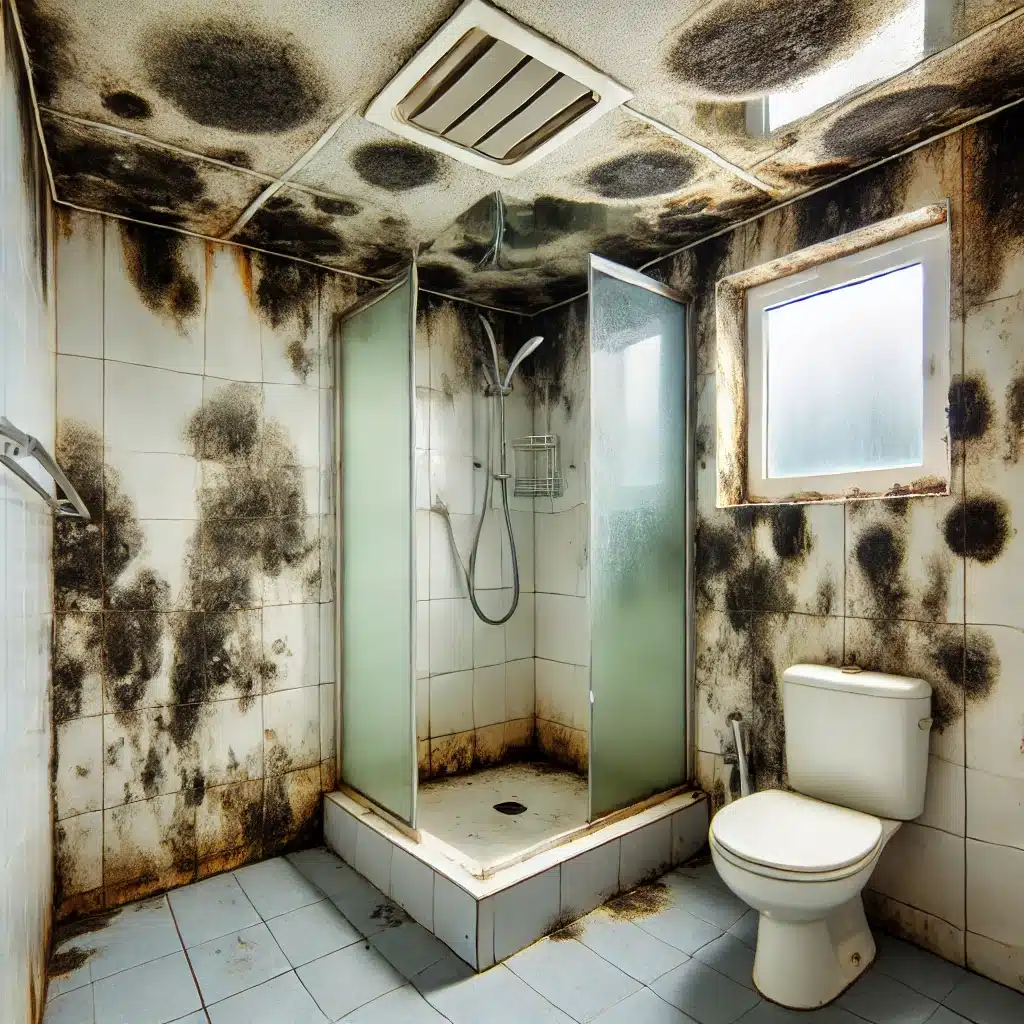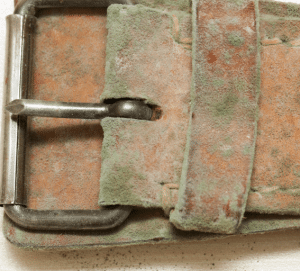Mold in the bathroom is a common issue many homeowners face due to the room’s high humidity and frequent exposure to water.
Those dark, slimy patches on your bathroom ceiling or between the tiles aren’t just unsightly; they can also pose serious health risks. Understanding how to identify, clean, and prevent mold is crucial for maintaining a healthy home environment.
Mold thrives in damp, warm environments, making bathrooms the perfect breeding ground. Whether it’s the steam from your morning shower, a leaky faucet, or poor ventilation, these factors can all contribute to mold growth. If left unchecked, mold can cause everything from minor allergic reactions to more severe respiratory problems.
But don’t worry – this guide is here to help! We’ll walk you through the differences between mildew and mold, common causes, and types of mold found in bathrooms.
We’ll also cover the best cleaning methods, products, and natural remedies for mold removal, along with tips for preventing mold growth and protecting your bathroom in the future.
Additionally, we’ll discuss the important of mold testing to ensure your bathroom remains mold-free. By following these steps, you can keep your bathroom clean, safe, and mold-free.
Mildew vs. Mold: What’s the Difference?
Mildew and mold are often confused, but they are distinct in terms of appearance, growth patterns, and impact.
Mildew typically appears as a powdery, white, or gray substance that rests on the surface of moist areas. It tends to grow in flat patches and is usually found on damp, organic materials like paper, fabrics, and grout between tiles. Mildew is relatively easier to clean and doesn’t usually cause significant damage or health issues if addressed promptly.
Mold, on the other hand, can be black, green, brown, or even orange. It has a fuzzy or slimy texture and penetrates the surface it grows on, making it more challenging to remove. Mold thrives on moisture and can grow on various surfaces, including walls, ceilings, and wood. It not only causes structural damage by breaking down the materials it infests but also poses more serious health risks. Prolonged mold exposure can lead to respiratory issues, allergic reactions, and other health complications.
What Causes Mold in Bathrooms?
Bathrooms are particularly prone to mold growth due to the constant presence of moisture. Common causes include poor ventilation, leaky faucets or pipes, standing water, and high humidity levels. Understanding these causes can help in taking preventive measures.
Types of Mold Commonly Found in Bathrooms
Bathrooms, with their constant exposure to moisture and warmth, provide the perfect environment for mold growth. Several types of mold are commonly found in these humid spaces, each with distinct characteristics and health implications. Understanding the differences among these molds can help in effectively identifying and removing them to maintain a healthy home environment.
Black Mold (Stachybotrys chartarum)
Black Mold (Stachybotrys chartarum) is perhaps the most notorious type of mold, known for its dark black or greenish-black appearance. It thrives on materials with high cellulose content, such as wood, drywall, and paper.
Having black mold in your bathroom is particularly dangerous because it produces mycotoxins, which can cause severe respiratory issues, chronic fatigue, and even neurological problems. Prompt and thorough removal by professionals is often recommended to ensure safety.
Green Mold (Aspergillus)
Green Mold (Aspergillus) appears as green or yellowish-green patches and can grow on a variety of surfaces, including walls, ceilings, and tiles.
This mold is less harmful than black mold but can still cause allergic reactions and respiratory problems, especially in individuals with weakened immune systems. Regular cleaning with mold-specific solutions can effectively manage green mold growth.
White Mold (Penicillium)
White Mold (Penicillium) typically looks powdery and white or light gray. It is often found on damp materials like insulation, wallpaper, and fabrics.
While it may seem less intimidating, white mold can cause respiratory issues and allergic reactions. Its ability to spread quickly means early detection and removal are crucial to prevent extensive contamination and damage.
Can Bathroom Mold Cause Illness?
Exposure to bathroom mold can lead to various health issues, ranging from mild allergic reactions to severe respiratory problems.
Symptoms include coughing, sneezing, skin rashes, and in some cases, chronic fatigue and headaches. Prolonged exposure can be particularly harmful to individuals with asthma or weakened immune systems.
How to Clean Mildew and Mold
Effective mold and mildew cleaning requires proper tools and techniques to ensure thorough removal and prevent future growth.
Here’s a detailed guide on how to clean mildew and mold from your bathroom:
Preparation and Safety
Before you start, gather the necessary protective gear: gloves, an N95 mask, and safety goggles. These items will protect you from inhaling mold spores and coming into direct contact with the mold or cleaning chemicals.
Also, ensure the area is well-ventilated by opening windows or using an exhaust fan to reduce the concentration of airborne mold spores and chemical fumes.
Choosing the Right Cleaning Solution
Select an appropriate cleaning solution based on the severity and location of the mold. Common options include:
- Bleach Solution: Mix one cup of bleach with one gallon of water. Bleach is highly effective at killing mold spores but can be harsh on surfaces.
- White Vinegar: Pour undiluted vinegar into a spray bottle. Vinegar is a natural, non-toxic option that kills many types of mold.
- Commercial Mold Removers: These are specifically formulated to target mold and mildew and are available at most home improvement stores.
Cleaning Process
- Apply the Solution: Spray the cleaning solution directly onto the moldy areas. If using bleach, ensure you do not mix it with other cleaners, especially ammonia, to avoid producing toxic fumes.
- Scrub Thoroughly: Use a soft brush or sponge to scrub the moldy surface. Pay extra attention to grout lines and corners where mold tends to hide. For stubborn mold, let the solution sit for 10-15 minutes before scrubbing.
- Rinse and Dry: After scrubbing, rinse the area with clean water to remove any remaining cleaning solution and mold residue. Dry the surface thoroughly using a towel or a fan to prevent moisture from lingering.
Post-Cleaning Steps
Once the mold is removed, take steps to prevent its return:
- Ensure Ventilation: Keep the bathroom well-ventilated by using exhaust fans or opening windows during and after showers.
- Regular Cleaning: Clean the bathroom regularly with mold-preventive solutions to keep mold at bay.
- Control Humidity: Use a dehumidifier to maintain lower humidity levels in the bathroom, ideally below 60%.
Natural Remedies for Mold Removal
For those who prefer eco-friendly solutions, natural remedies like white vinegar, baking soda, and tea tree oil can be effective in removing mold.
- White Vinegar: White vinegar is acidic and can kill up to 82% of mold species, making it an effective natural cleaner for non-porous surfaces.
- Baking Soda: Baking soda is a mild abrasive that helps scrub away mold and mildew while deodorizing the area, making it ideal for use in bathrooms.
- Tea Tree Oil: Tea tree oil is a powerful antifungal and antibacterial essential oil that, when diluted with water, can effectively eliminate mold and prevent its return.
Read Also: How to Get Mold Off Bathroom Ceilings
Preventing Mold Growth in Bathrooms
Preventing mold growth in bathrooms is essential for maintaining a healthy and clean environment. Mold thrives in moist, warm conditions, making bathrooms particularly susceptible.
Here are some comprehensive strategies to keep mold at bay:
Control Moisture Levels
Controlling moisture is the most crucial step in preventing mold. After using the shower or bath, make sure to wipe down wet surfaces, such as walls, floors, and fixtures.
This simple habit can significantly reduce the amount of moisture lingering in your bathroom. Additionally, promptly fix any leaks from faucets, showerheads, or pipes to prevent water from seeping into walls and floors where mold can easily develop.
Ensure Proper Ventilation
Good ventilation is key to keeping your bathroom dry. Use exhaust fans during and after showers to remove excess moisture from the air.
If your bathroom doesn’t have an exhaust fan, consider installing one. Opening windows when weather permits can also help improve air circulation and reduce humidity. For bathrooms with no windows, leaving the door open after use can help dissipate moisture.
Use a Dehumidifier
In areas with high humidity, using a dehumidifier can help maintain appropriate moisture levels in your bathroom.
Aim to keep humidity levels below 60% to make the environment less conducive to mold growth. Humidity monitors can help you keep track of moisture levels and adjust your dehumidifier settings as needed.
Regular Cleaning and Maintenance
Regular cleaning is essential in preventing mold. Use mold-preventive cleaners on a weekly basis, focusing on areas prone to moisture, such as the shower, bathtub, sink, and toilet.
Pay special attention to grout lines and caulk, which can harbor mold spores. Replace any damaged or moldy caulking and grout promptly to prevent mold from spreading.
Additional Tips
Consider using mold-resistant products, such as mold-resistant paint and drywall, especially in areas that frequently get wet.
These products contain antimicrobial properties that inhibit mold growth. Regularly inspect your bathroom for signs of mold or moisture problems, such as musty odors or discoloration on walls and ceilings, and address them immediately.
FAQs on Bathroom Mold
Is it safe to use bleach for mold removal?
Yes, bleach is effective for mold removal, but it should be used with caution. Ensure the area is well-ventilated to avoid inhaling fumes. Wear protective gear, such as gloves and an N95 mask, to protect your skin and respiratory system. Bleach is particularly effective on non-porous surfaces like tiles and glass.
Can mold cause permanent damage to bathroom surfaces?
Yes, if left untreated, mold can cause permanent damage to bathroom surfaces and structural elements. Mold can penetrate porous materials like drywall and wood, leading to rot and weakening the structural integrity. Prompt removal and prevention measures are essential to avoid costly repairs.
Are natural remedies as effective as commercial mold removers?
Natural remedies, such as vinegar and baking soda, can be effective for mild mold issues. They are safe and eco-friendly options. However, severe infestations may require stronger commercial products or professional intervention to ensure thorough removal and prevent recurrence.
How can I detect mold behind drywall in my bathroom?
Mold behind drywall in bathrooms is a hidden danger that can lead to serious structural damage and health issues. Look for signs such as a musty odor, discoloration, or peeling paint. If you suspect mold behind your drywall, it’s important to address it immediately. Professional mold remediation services are often necessary to safely remove mold and replace affected materials.
What are the common signs and types of mold in bathrooms?
Identifying molds in your bathroom involves looking for visible signs such as discoloration (black, green, or white patches), a musty odor, and damp spots. Black mold (Stachybotrys chartarum), green mold (Aspergillus), and white mold (Penicillium) are common types. If you’re unsure about the type or severity of mold, consider using a mold test kit or consulting a professional for accurate identification and appropriate treatment.
Wrapping Up
Bathroom mold is a common yet manageable problem that many homeowners encounter. Understanding the causes of mold growth, such as high humidity, poor ventilation, and water leaks, is crucial in combating this issue.
Mold can pose significant health risks, including respiratory problems and allergic reactions, making it essential to address any signs of mold promptly. By familiarizing yourself with the best methods for cleaning and preventing mold, you can ensure that your bathroom remains a safe and healthy space for you and your family.
Regular maintenance and proactive measures are key to keeping your bathroom mold-free. This includes ensuring proper ventilation, promptly fixing leaks, wiping down wet surfaces, and controlling humidity levels. Regular cleaning with mold-preventive solutions and using mold-resistant materials can also make a significant difference.





